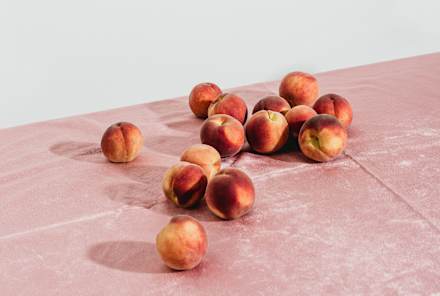Advertisement
A Guide To Selling Used Clothes — From People Who Do It All The Time


Selling your used clothes is a surefire way to keep them out of the landfill and make some money doing it. And while a growing number of online marketplaces make the process easier than ever, it can still be a bit overwhelming—especially for beginners.
Here, secondhand fashion buyers, sellers, and execs spill market-tested tips for making a sale, plus share their favorite places to sell, both online and IRL.
How to sell your clothes
Make sure they're in good shape
When deciding which items to list, you'll want to be realistic about what actually has a chance of selling.
Anything that has prominent holes, discoloration, or stains will be better off recycled.
"A good rule of thumb is to imagine you're giving these clothes to your BFF," Madeline Cronin Aaronson, brand director at online consignment and thrift store thredUP, tells mindbodygreen.
Give any items that make the cut a good wash before listing them. You'll also want to get rid of any stains, mend holes and rips, and cut any loose threads.
Photograph them in good lighting—preferably on a person
While some resale platforms handle photographing and listing your items for you, you'll usually have to do this yourself. And since the photo is your chance to sell the garment, it's worth taking the time to get it just right.
Photos that you take yourself will typically be better than stock photography pulled from online, as it shows you actually own the garment and are not just selling new garments directly from a brand (a growing concern in the secondhand space, called drop shipping).
Aim to take your pictures in natural lighting in front of a neutral background, suggests Poshmark seller and ambassador Coco Kapfer. "Most buyers shop on their phones, where the image is small, so the photo needs to be clear and pop out," Kapfer explains.
"People like to see what it will look like on," adds Tyler Chanel, the ethical blogger behind Thrifts and Tangles, so she recommends photographing the piece on a person or mannequin/half-mannequin.
Sustainable fashion advocate of Acteevism Megan McSherry has also found success photographing her pieces on actual humans. "I've had countless items that I'd taken pictures of hanging up or flat-laid on the ground that were not selling; there was no interest," she tells mbg. "Then when I just retook photos of me wearing them, they immediately sold."
Once you have a clear cover photo that captures what the item looks like on, Chloe Baffert, a merchandising and curation expert at Poshmark, recommends snapping a few shots that speak to the details of the piece.
Poshmark allows sellers to post up to eight of these extra photos, and Baffert says that listings with at least four pictures are 70% more likely to be sold on the platform. Another Poshmark ambassador, Suzanne Butler, says she always includes shots of her garment's front, back, label, and care tags, for example.
Your photography checklist:
- Take photos yourself
- Use a neutral background
- Photograph clothes in natural light (preferably on a person!)
- Include detail shots (pockets, care tags, etc.)
Give plenty of details with your listing
You'll want to post your photo with the measurements of your garment and a disclosure about any imperfections it may have; nothing is too small.
"It's better to be cautious than to get slammed with like a horrible rating," notes McSherry, adding that flagging even minor signs of wear and tear, like a stain on the inside of a shirt, helps build trust with your buyers.
Aaronson adds that it's also worthwhile to write about any investments you've made to extend the life of the item—like placing a fresh sole in sneakers or sewing new buttons on a blouse.
Be sure to include the brand name in your description of the item, too!
Do your research to price them fairly
If you have no idea how much a used item is worth, McSherry recommends first looking up the price that it sold for new (depending on the brand, you can usually find out with a quick Google search).
From there, you can check how much money similar items have sold for recently. If a pair of used jeans sold for $60, for example, you could start your listing at $75, knowing that you can always lower the price as time goes on.
Some platforms also have special tools to help you price your items based on buyer demand, which we'll cover more below.
"If you are aware of what's trending in the secondhand space, you can price things a little bit higher and still get a sale relatively quickly," McSherry notes.
Know what to list and where
Each platform will have a slightly different clientele, so something that's super hot on one might be a dud on the other.
That being said, there are a few categories that are almost always popular across the secondhand market and therefore have a higher chance of being sold.
These include gently used sneakers (since they can be tough to find IRL thrift stores), vintage items ("We've seen vintage sales increase 85% over the past two years," notes Baffert of Poshmark), occasion dresses for weddings, seasonal items (sunglasses in the summer, puffers in the winter), and anything that's trending on TikTok.
Bring down the price or re-list after a few months
Your listing can sell within a matter of minutes or it could take months to get the offer you want. Patience is key, but Kapfer will typically reassess a listing if three months have passed with no leads.
"If it hasn't sold, I ask myself: Does it need better photos? Could my title or description use better words for search? Is the price competitive?" she explains.
If you're confident in your post and pricing, McSherry adds that simply resharing the listing so it appears on the top of your seller page can also help. Sharing your listing on Pinterest or another social media site can also give it a quick boost, Butler's found.
5 best places to sell clothes online
As secondhand fashion continues to have its rightful moment in the sun, dozens of online marketplaces have emerged to help people list their used clothes. These five come recommended by people with tons of experience selling.
Each platform is set up a bit differently, so you'll want to consider factors like how much money you're hoping to make and how much time you have to spend before choosing one:
ThredUP
- Pros: Lists items for you, attempts to recycle and reuse items that are not sold
- Cons: Pays sellers less than other sites
- Best for: ThredUp's top 5 most popular brands in resale in 2023 are Torrid, Lululemon, Madewell, Zara, and Free People
- Effort to post: Easy
- Potential payout: $
ThredUP is an online consignment and thrift store that accepts used clothing from 35,000-plus women's and children's brands.
The unique thing about thredUP is that they list your clothes for you. All you do is put everything you're hoping to sell in one of their free clean-out bags, send it in with a prepaid shipping label, and wait to hear back on which items they've accepted and will put on sale.
You'll receive anywhere from 5 to 80% of the listing price on these items, depending on the garment condition, retail price, etc. For items thredUP won't sell, you can choose to take them back or leave them with thredUP to be repurposed or recycled. You can either accept your earnings as cash or receive a thredUP shopping credit.
After years of listing every garment online individually on other platforms, Chanel was happy to find thredUP's super straightforward model. "They just make it so easy," she notes—no photography, pricing, or marketing required to make a sale.
One downside is that the payout on thredUP tends to be much lower for sellers (she's never gotten more than $10 or so for a garment), but she thinks it makes sense because "they're doing all the work."
At a glance
Poshmark
- Pros: Offers pricing and trend guidance, makes it easy to re-list items, provides a shipping label
- Cons: You have to list all items yourself
- Best for: Basics from classic brands like J Crew, Gap, and LOFT; sustainable capsule wardrobe items; athleisure
- Effort to post: Medium
- Potential payout: $$
Poshmark is all about creating a community around resale, and the platform touts a number of user-friendly features. They offer price guidance for sellers, share regular trend reports on what's been selling, and host virtual events where you can connect with other shoppers and sellers.
Though it requires photographing and pricing your own pieces, McSherry has had a lot of success using Poshmark to sell basics from classic name-brand items that people will recognize, like J Crew, Gap, and LOFT. Aaronson adds that capsule wardrobe items from brands like Cuyana and Jenni Kayne, as well as athleisure, are also popular on the platform.
McSherry appreciates that Poshmark makes it easy to relist items that haven't been quick sells. The marketplace also features a nifty "Reposh" feature that lets you automatically re-list anything that you bought on Poshmark and are ready to part ways with.
Once you make a sale, Poshmark will email you a prepaid shipping label to use to send your items.
At a glance
Depop
- Pros: Good for selling cool, unique styles
- Cons: You have to list all items yourself, does not provide prepaid shipping labels
- Best for: Vintage pieces, one-of-a-kind pieces, streetwear
- Effort to post: Hard
- Potential payout: $$
Depop is popular among younger shoppers looking for unique secondhand finds they can't get anywhere else. (90% of the company's active users are under 26.)
"It's more aesthetics-based," notes McSherry, who has found that taking the extra time to style your clothing is super important on this platform. But if you can help shoppers imagine how your listing will fit into their closets, she says it's possible to make a good profit on each sale.
Depop charges a 10% fee on each item sold. When an item sells, it's up to the buyer to send it out and track its delivery.
At a glance
eBay
- Pros: Can list almost everything, high payout
- Cons: You have to list all items yourself, does not provide prepaid shipping labels
- Best for: Pretty much anything but especially vintage pieces and specialty items like themed sweaters
- Effort to post: Medium
- Potential payout: $$
Getting the hang of selling on this massive marketplace takes some effort, but it can be well worth it. "It's really time-consuming, but you can get a lot more money for your items," says Chanel.
The listing possibilities are really endless for eBay. Besides clothes, you might have success selling household items like electronics, appliances, and even old VHS tapes and CDs.
Once you decide what to sell, Chanel appreciates eBay's filter feature that allows you to see how much money similar items have sold for recently. You can either set your own price or opt for an auction-style listing where buyers bid on your items for a set number of days.
eBay charges a ~12.5% fee on each item sold. When an item sells, it's up to the buyer to send it out and track its delivery.
At a glance
StockX
- Pros: High payout, you don't need to list items yourself
- Cons: No guaranteed sale, only accepts a small number of items
- Best for: Streetwear, sneakers
- Effort to post: Easy
- Potential payout: $$$
If you have sneakers or streetwear to sell, StockX is a marketplace to check out. The platform specializes in collector's clothing and gets a bit more involved in each sale to make sure that every item listed is legit.
StockX handles matching buyers who create a bid on a particular item (say, a Supreme T-shirt for $75) and a seller who has that item and will accept that price. Once a match is made, the seller will send the item to StockX, where they'll authenticate it and handle sending it out to the buyer.
The appeal of this system is that, as a buyer, you have a sense of what people are willing to pay for your item right away. You also don't have to worry about covering shipping costs, meaning you can get paid really well if you have the right item—even after the 8-10% transaction fee. "It's the highest payout I've seen," Chanel says of the platform.
At a glance
Selling used clothes in person
If online selling isn't for you, you can also try to make an in-person sale at a secondhand retailer. The benefit of this approach is that you can sell a bunch of items at once and get paid right away. The risk is that there's no guarantee the retailer will accept what you're selling.
"They're usually looking for very specific things," says McSherry, but she adds that doing a little research can reduce your chance of walking out of the store empty-handed.
She notes that shops like Buffalo Exchange and Crossroads Trading will usually share what they're looking to buy at any time—either through trend cards in their shop or posts on Instagram. By looking at those before sifting through her closet, McSherry has been able to make a number of in-person sales.
While she notes that you probably won't make as much money selling in person as you do online, it can be much easier and less time-consuming depending on where you live.
Places that will buy your clothes in person:
- Buffalo Exchange
- Crossroads Trading
- Plato's Closet
- Beacon's Closet
- Once Upon A Child (kid's clothes)
Meeting up with friends for a clothing sale or swap is also an option, and you can always look to donate any clothes that you don't need to make a profit on. Recycling can be a last resort for clothes that are no longer fit to wear.
Frequently Asked Questions
Is it worth it to sell used clothes?
How can I sell secondhand clothes successfully?
The key is to sell clothes that are in good shape, list them on the right platform, choose a fair price, and include flattering photography.
The takeaway
Selling your used clothes is a great way to keep them out of the landfill—but it does require some time and know-how. If you're willing to put in the work, though, you can make good money on old clothing that you can then put toward your own secondhand shopping fund.
Editor's Note: This article was originally published on July 5, 2022. A previous version of this article indicated that vintage clothing sales have increased by 85% on thredUP over the past two years. We have since clarified that vintage clothing sales have increased by 85% on Poshmark over the past two years.











